Harvest has become “a time of relaxation” for Illinois tillage farmer Sarah Hastings, as she can just hop into her semi-truck, haul grain from the fields to the elevator, and monitor in real-time what her crops are yielding.
It’s a break from the daily grind of herself, and her husband, Brandon’s, burgeoning grain bin business, Hastings CCI Equipment Co, which currently takes about 65% of her activity keeping up with bills, getting quotes to farmers and maintaining customer service.
Sarah harvests alongside her full-time farmhand driving the combine, her dad, Dave, towing the auger wagon, while Brandon is out fixing fans, burners and motors for neighbours they’ve supplied with custom-built storage systems.
Though this year’s harvest began slower than usual on the extended Hastings’ family holding – comprising 1,750ac of traditional corn (maize) and soybean crops raised on some of the most fertile ground in the Midwestern corn belt of the US – it also came after a challenging growing season.
No rain for six weeks, followed by four to five weeks of a hazy smoke that drifted south from Canadian wildfires, led to major weed control pressures for Sarah – whose family has some Irish roots from counties Laois and Cork – as the chemical herbicides did not activate in their huge flat fields.
When precipitation finally fell in late June/early July, it came with an 80m/hr wind storm that smashed three of their grain bins, along with others on neighbouring farms, with two bins almost rolling into the front yard of their home near the village of Sidney in Champaign County.
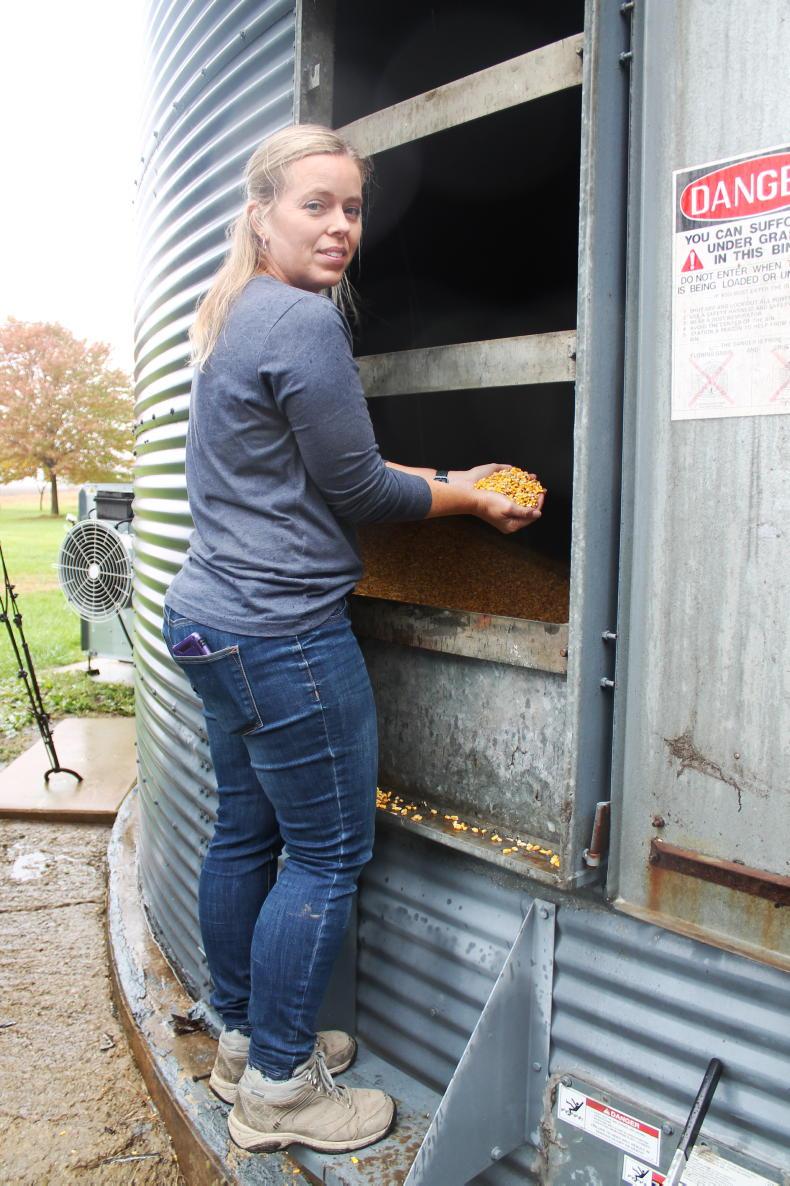
Sarah Hastings testing the moisture quality of corn. \ Claire McCormack
Fortunately, the gales were 30ft high, so their crops were saved from the force, however five electricity poles collapsed onto their land too.
Though such dramatic weather events are relatively rare, the mum-of-one – her son, Ryan, is aged 13 – told the Irish Farmers Journal she has learned to adapt, as she sat at her kitchen table during a thunderous downpour in late October.
“I tell myself, ‘there is nothing I can do to control the weather’. In 2009 nothing dried down, it was the wettest year, and I had Christmas lights on the tractor, we combined until 23 December because we had to wait for it to freeze.
“In 2012 we had a severe drought and our whole farm averaged 112 bushels for corn per acre [one bushel of corn equates to about 25kg], whereas this year we’re averaging 224 bushels per acre, which is pretty high, and shocking to me because it didn’t rain.
“Mostly we have beautiful falls with really good weather and we have a pretty big growing window.
“Typically by early September people have started in the fields and we can harvest until much later. Two years ago I had some down corn and harvested until late November. But if the weather is good and my corn is dry, we can do 80-100ac in a 12-hour day.
“We’re starting to harvest corn we planted a little later this year, around 17 May. It didn’t have as much drought stress as the crop planted two weeks earlier, we can see the difference. It’s two foot higher, much greener, ears are bigger, so I’m hoping we might even see a bump-up in yields.”
Planting their genetically modified crops a little later has become relatively routine for the Hastings, due to increasing customer demand for their grain bins.
“We say ‘our cash crop is grain bins’ because that’s where we make our money. We build five to 10 bins a year. We jokingly call our farm ‘a hobby farm’.
“We tend to plant late season crops, Brandon plants the corn, I plant our beans.
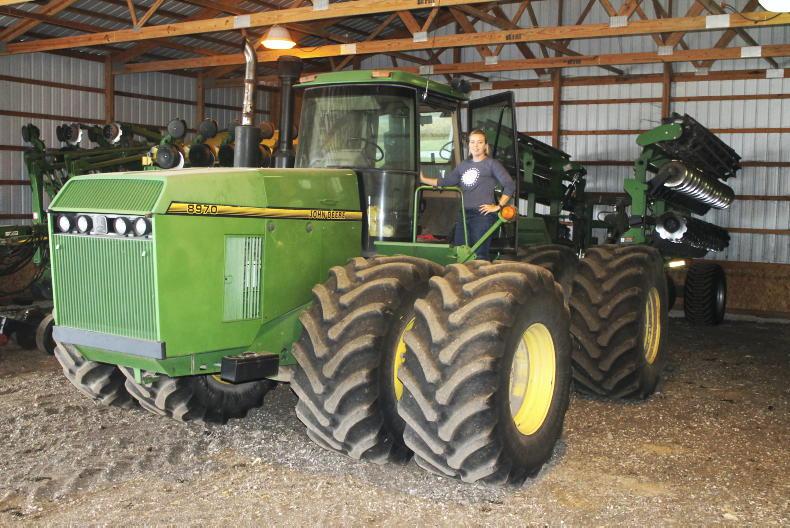
Sarah Hastings. \ Claire McCormack
“This year we had a lot of weed pressure that we usually don’t have. By the time we got rain, the weeds were too tall to spray so we’re going to have a lot of weed problems for a few years.”
As much of their holding is covered by a dark, poorly-drained soil called ‘drummer soil’, designated as prime farmland by the US Department of Agriculture due to its very high productivity index, they also opt for minimum-to-low tillage practices.
“We don’t want to overturn our ground, kill our earthworms or lose our nutrients. Anything we put in the soil, if the crop doesn’t use it, it should sit there and wait, it’s very good at holding onto minerals.
“We will go a little heavier this year with a second pass with our high-speed disk to chop up those weeds. I’m hoping for a really good deep freeze too.”
Sarah, who studied Animal Science at the University of Illinois Urbana-Champaign and sits on the board of the Illinois Corn Growers Association, outlined other environmental actions taken to avoid soil erosion and run-off. Everything here flows south to the Gulf of Mexico.
“Some of our fields have drainage ditches around them and we’ve field borders and buffers through our Conservation Reserve Program. I also have some pollinator plots with native grasses and flowers.”
Though contemplating cover crops, Sarah is concerned about potential economic impact.
“We haven’t done cover crops because we go after really high-yielding soybeans, so it would be really hard for us to do it.
“Soybeans like really warm, black dirt to start growing and you get that by higher tillage and getting that seed out early. If I’ve a cover crop I’ll probably be a month to six weeks later getting my crop out because you’d have to plant into it or kill it.”
On production costs, Sarah says her corn has increased by about $100/ac (€92.78/ac) to $650/ac (€603/ac) due to “skyrocketing” nitrogen bills of $950/t (€881/t) up from $350-$400/t (€324-€371/t) in recent years. Soybeans have been a little cheaper, at closer to $450-500/ac (€417-€463/ac).
“We try to be very efficient with our nitrogen. We do two types of fertiliser with our planter – a food-grade fertiliser we put in with the seed when it starts growing so it has all the micro-nutrients it needs so.
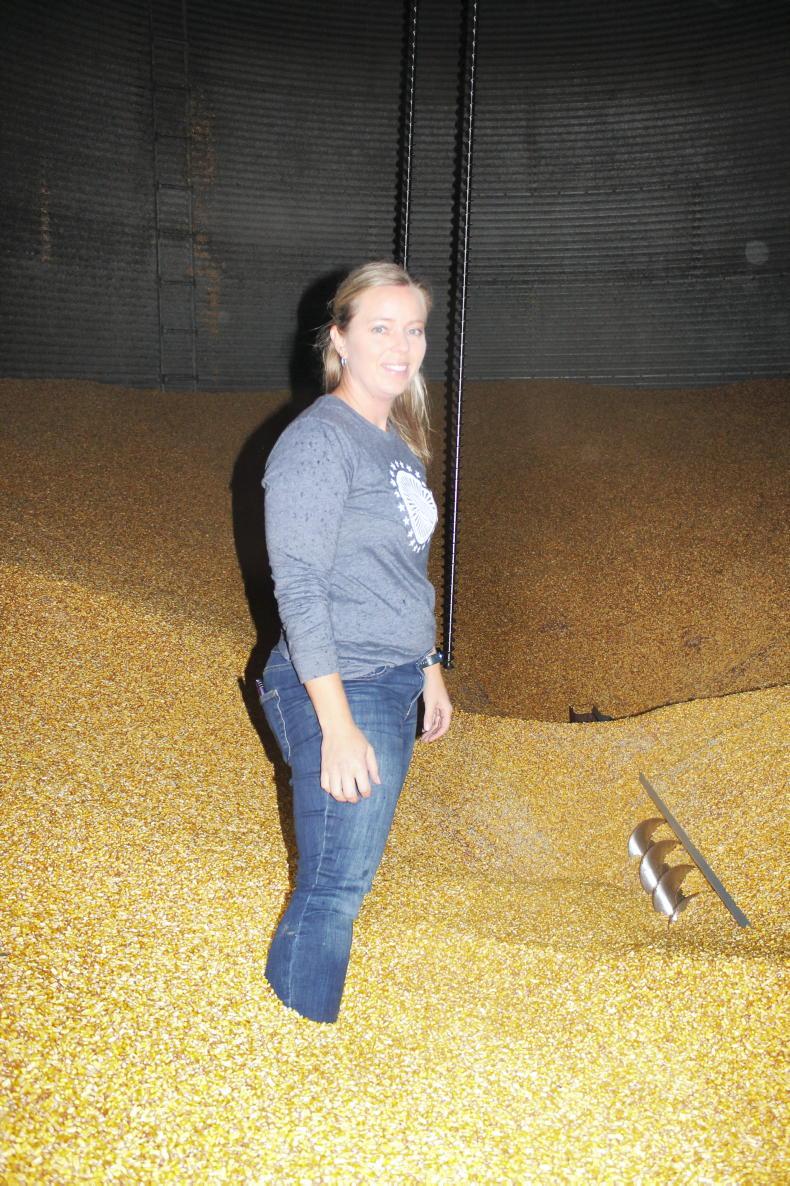
Sarah Hastings. \ Claire McCormack
“The rest we put over the closing wheel of the furrow, it squirts a custom blend of 32% urea-ammonium nitrate and ammonium thio-sulphate.
“We mix that in over the top of the dirt so as soon as the start-up fertiliser gets that seed growing the plant has all the nitrogen it needs.”
Unlike most growers around, Sarah stores all their crop before selling to Premier Co-Operative in Sidney where it goes towards agricultural commodities and energy products, including animal feed and ethanol production. With access to the nation’s largest rail gateway, Sarah’s grain can also go west to feedlots or south for international export.
“Historically harvest time is your lowest price because of supply and demand, everybody’s got corn, so the elevators don’t have to pay high.
“By storing our crops it gives us more options so we can get 10 more cents per bushel.
“We can store about 220,000 bushels. I have three bins for beans, each stores about 20,000 bushels, everything else is allocated towards corn. My biggest grain bin is 50,000 bushels.
“What helps us most is the basis, the difference between the Chicago Board of Trade price and what your local elevator will give you, which could be a 70-80c swing per bushel. Commodity prices now are pretty high. If your target is to make $6/bushel (€5.58) and you get $5.90 (€5.48), that is still a good price, but you must know your cost of production.
“We sell futures, so if it looks for March 2024 that corn is trending higher we will lock in that sell. But if the price goes up or down we pay the difference, so we have margin calls which can be very rough.”
For now, Sarah says their focus remains on the grain bin side, as escalating land and machinery prices limit further farm expansion in the short-term.
“Farm ground here is very expensive. The piece behind us came up for sale during COVID-19 and it no-saled at $9,000/ac (€8,364). Now we’re seeing land go for $20,000-$22,000/ac (€18,588-€20,447) and people are bidding hard up to that level.
“We’ve been unbelievably lucky, we farm with extended family on all family ground, which is very unique. We own all our machinery, combine, tractors, planters, two semi-trucks, tillage equipment.
“But my combine cost more than my house – and that’s just one piece of equipment without a head on it. A brand new bean head right now is $109,000 (€101,306).
“So for now our grain bins remain the focus, it’s growing rapidly, every year we get new customers, we’re just trying to keep up. We jokingly say ‘we want to retire to just farm’.
“People also laugh when I say ‘harvest has really become my relaxation time’. But everyone is out, you’re waving at neighbours, we’re sending each other Snapchats, it’s fun, it’s the reward part for me.
“I just go out and try to do my best every day to get closer to being done. Thankfully, we’ve never had an autumn where we didn’t get everything out.
“I’m very proud to farm in Illinois, it’s something that you can quickly take for granted when you’re just trying to make a piece of ground as productive as possible.
“But I’ve travelled across the country and when I mention that we’re getting 220 bushels of corn per acre without any irrigation, people are just baffled. Right here we have the best soil in the world.”
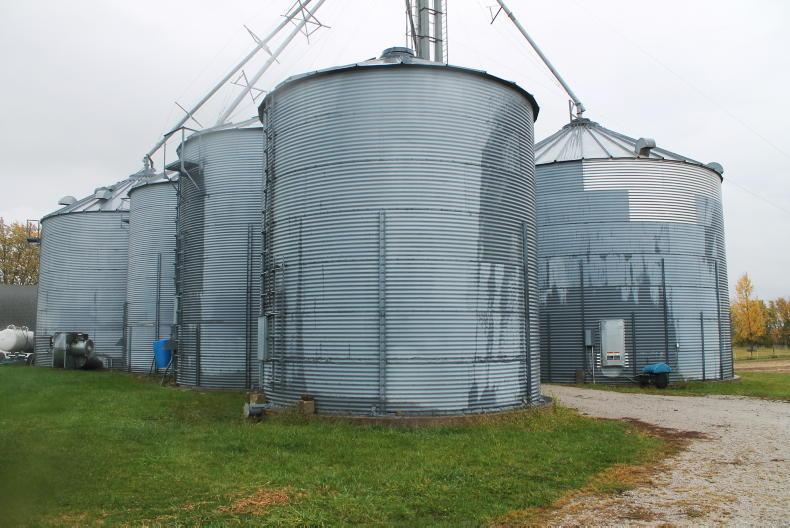
Sarah Hastings' grain bins have filled up with this year's harvest. \ Claire McCormack
Fact box – Illinois agriculture
Farmland covers about 75% (27m acres) of the total land area of the state.Illinois is a leading producer of soybeans, corn and pigs. It is the nation’s second leading exporter of both soybeans and feed grains. Approximately 44% of grain produced in Illinois is sold for export.Illinois has some 72,000 farms averaging 375ac – with most acreage devoted to corn and soybeans.Beef cows are found on about 22% of farms, about 3% of Illinois farms have pigs, while about 1% have dairy cows.An estimated at 11m acres of land were planted in corn in 2023, up 4% on 2022.An estimated 10m acres of land were planted in soybeans in 2023, up 4% on 2022.Marketing of Illinois’ agricultural commodities generates more than $5bn annually. Crops account for 40% of that total.Illinois typically experiences cold, fairly dry winters and warm, humid summers with ample rainfall.About 89% of the state’s cropland is considered prime farmland, ranking the state third nationally in total prime farmland acreage.Illinois has a competitive edge over many other states due to its central location and superior transportation system, including interstate, railway, air travel and waterways.(Source: United States Department of Agriculture)
Harvest has become “a time of relaxation” for Illinois tillage farmer Sarah Hastings, as she can just hop into her semi-truck, haul grain from the fields to the elevator, and monitor in real-time what her crops are yielding.
It’s a break from the daily grind of herself, and her husband, Brandon’s, burgeoning grain bin business, Hastings CCI Equipment Co, which currently takes about 65% of her activity keeping up with bills, getting quotes to farmers and maintaining customer service.
Sarah harvests alongside her full-time farmhand driving the combine, her dad, Dave, towing the auger wagon, while Brandon is out fixing fans, burners and motors for neighbours they’ve supplied with custom-built storage systems.
Though this year’s harvest began slower than usual on the extended Hastings’ family holding – comprising 1,750ac of traditional corn (maize) and soybean crops raised on some of the most fertile ground in the Midwestern corn belt of the US – it also came after a challenging growing season.
No rain for six weeks, followed by four to five weeks of a hazy smoke that drifted south from Canadian wildfires, led to major weed control pressures for Sarah – whose family has some Irish roots from counties Laois and Cork – as the chemical herbicides did not activate in their huge flat fields.
When precipitation finally fell in late June/early July, it came with an 80m/hr wind storm that smashed three of their grain bins, along with others on neighbouring farms, with two bins almost rolling into the front yard of their home near the village of Sidney in Champaign County.

Sarah Hastings testing the moisture quality of corn. \ Claire McCormack
Fortunately, the gales were 30ft high, so their crops were saved from the force, however five electricity poles collapsed onto their land too.
Though such dramatic weather events are relatively rare, the mum-of-one – her son, Ryan, is aged 13 – told the Irish Farmers Journal she has learned to adapt, as she sat at her kitchen table during a thunderous downpour in late October.
“I tell myself, ‘there is nothing I can do to control the weather’. In 2009 nothing dried down, it was the wettest year, and I had Christmas lights on the tractor, we combined until 23 December because we had to wait for it to freeze.
“In 2012 we had a severe drought and our whole farm averaged 112 bushels for corn per acre [one bushel of corn equates to about 25kg], whereas this year we’re averaging 224 bushels per acre, which is pretty high, and shocking to me because it didn’t rain.
“Mostly we have beautiful falls with really good weather and we have a pretty big growing window.
“Typically by early September people have started in the fields and we can harvest until much later. Two years ago I had some down corn and harvested until late November. But if the weather is good and my corn is dry, we can do 80-100ac in a 12-hour day.
“We’re starting to harvest corn we planted a little later this year, around 17 May. It didn’t have as much drought stress as the crop planted two weeks earlier, we can see the difference. It’s two foot higher, much greener, ears are bigger, so I’m hoping we might even see a bump-up in yields.”
Planting their genetically modified crops a little later has become relatively routine for the Hastings, due to increasing customer demand for their grain bins.
“We say ‘our cash crop is grain bins’ because that’s where we make our money. We build five to 10 bins a year. We jokingly call our farm ‘a hobby farm’.
“We tend to plant late season crops, Brandon plants the corn, I plant our beans.

Sarah Hastings. \ Claire McCormack
“This year we had a lot of weed pressure that we usually don’t have. By the time we got rain, the weeds were too tall to spray so we’re going to have a lot of weed problems for a few years.”
As much of their holding is covered by a dark, poorly-drained soil called ‘drummer soil’, designated as prime farmland by the US Department of Agriculture due to its very high productivity index, they also opt for minimum-to-low tillage practices.
“We don’t want to overturn our ground, kill our earthworms or lose our nutrients. Anything we put in the soil, if the crop doesn’t use it, it should sit there and wait, it’s very good at holding onto minerals.
“We will go a little heavier this year with a second pass with our high-speed disk to chop up those weeds. I’m hoping for a really good deep freeze too.”
Sarah, who studied Animal Science at the University of Illinois Urbana-Champaign and sits on the board of the Illinois Corn Growers Association, outlined other environmental actions taken to avoid soil erosion and run-off. Everything here flows south to the Gulf of Mexico.
“Some of our fields have drainage ditches around them and we’ve field borders and buffers through our Conservation Reserve Program. I also have some pollinator plots with native grasses and flowers.”
Though contemplating cover crops, Sarah is concerned about potential economic impact.
“We haven’t done cover crops because we go after really high-yielding soybeans, so it would be really hard for us to do it.
“Soybeans like really warm, black dirt to start growing and you get that by higher tillage and getting that seed out early. If I’ve a cover crop I’ll probably be a month to six weeks later getting my crop out because you’d have to plant into it or kill it.”
On production costs, Sarah says her corn has increased by about $100/ac (€92.78/ac) to $650/ac (€603/ac) due to “skyrocketing” nitrogen bills of $950/t (€881/t) up from $350-$400/t (€324-€371/t) in recent years. Soybeans have been a little cheaper, at closer to $450-500/ac (€417-€463/ac).
“We try to be very efficient with our nitrogen. We do two types of fertiliser with our planter – a food-grade fertiliser we put in with the seed when it starts growing so it has all the micro-nutrients it needs so.

Sarah Hastings. \ Claire McCormack
“The rest we put over the closing wheel of the furrow, it squirts a custom blend of 32% urea-ammonium nitrate and ammonium thio-sulphate.
“We mix that in over the top of the dirt so as soon as the start-up fertiliser gets that seed growing the plant has all the nitrogen it needs.”
Unlike most growers around, Sarah stores all their crop before selling to Premier Co-Operative in Sidney where it goes towards agricultural commodities and energy products, including animal feed and ethanol production. With access to the nation’s largest rail gateway, Sarah’s grain can also go west to feedlots or south for international export.
“Historically harvest time is your lowest price because of supply and demand, everybody’s got corn, so the elevators don’t have to pay high.
“By storing our crops it gives us more options so we can get 10 more cents per bushel.
“We can store about 220,000 bushels. I have three bins for beans, each stores about 20,000 bushels, everything else is allocated towards corn. My biggest grain bin is 50,000 bushels.
“What helps us most is the basis, the difference between the Chicago Board of Trade price and what your local elevator will give you, which could be a 70-80c swing per bushel. Commodity prices now are pretty high. If your target is to make $6/bushel (€5.58) and you get $5.90 (€5.48), that is still a good price, but you must know your cost of production.
“We sell futures, so if it looks for March 2024 that corn is trending higher we will lock in that sell. But if the price goes up or down we pay the difference, so we have margin calls which can be very rough.”
For now, Sarah says their focus remains on the grain bin side, as escalating land and machinery prices limit further farm expansion in the short-term.
“Farm ground here is very expensive. The piece behind us came up for sale during COVID-19 and it no-saled at $9,000/ac (€8,364). Now we’re seeing land go for $20,000-$22,000/ac (€18,588-€20,447) and people are bidding hard up to that level.
“We’ve been unbelievably lucky, we farm with extended family on all family ground, which is very unique. We own all our machinery, combine, tractors, planters, two semi-trucks, tillage equipment.
“But my combine cost more than my house – and that’s just one piece of equipment without a head on it. A brand new bean head right now is $109,000 (€101,306).
“So for now our grain bins remain the focus, it’s growing rapidly, every year we get new customers, we’re just trying to keep up. We jokingly say ‘we want to retire to just farm’.
“People also laugh when I say ‘harvest has really become my relaxation time’. But everyone is out, you’re waving at neighbours, we’re sending each other Snapchats, it’s fun, it’s the reward part for me.
“I just go out and try to do my best every day to get closer to being done. Thankfully, we’ve never had an autumn where we didn’t get everything out.
“I’m very proud to farm in Illinois, it’s something that you can quickly take for granted when you’re just trying to make a piece of ground as productive as possible.
“But I’ve travelled across the country and when I mention that we’re getting 220 bushels of corn per acre without any irrigation, people are just baffled. Right here we have the best soil in the world.”

Sarah Hastings' grain bins have filled up with this year's harvest. \ Claire McCormack
Fact box – Illinois agriculture
Farmland covers about 75% (27m acres) of the total land area of the state.Illinois is a leading producer of soybeans, corn and pigs. It is the nation’s second leading exporter of both soybeans and feed grains. Approximately 44% of grain produced in Illinois is sold for export.Illinois has some 72,000 farms averaging 375ac – with most acreage devoted to corn and soybeans.Beef cows are found on about 22% of farms, about 3% of Illinois farms have pigs, while about 1% have dairy cows.An estimated at 11m acres of land were planted in corn in 2023, up 4% on 2022.An estimated 10m acres of land were planted in soybeans in 2023, up 4% on 2022.Marketing of Illinois’ agricultural commodities generates more than $5bn annually. Crops account for 40% of that total.Illinois typically experiences cold, fairly dry winters and warm, humid summers with ample rainfall.About 89% of the state’s cropland is considered prime farmland, ranking the state third nationally in total prime farmland acreage.Illinois has a competitive edge over many other states due to its central location and superior transportation system, including interstate, railway, air travel and waterways.(Source: United States Department of Agriculture)










 This is a subscriber-only article
This is a subscriber-only article





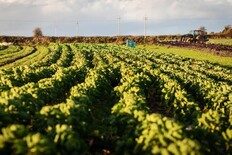
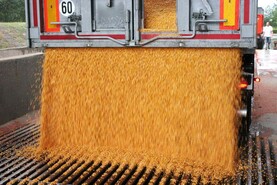



SHARING OPTIONS: